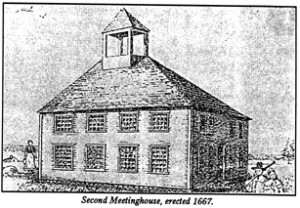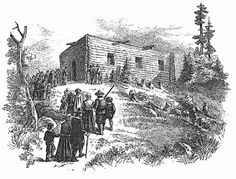The development of New England towns explains much about their current form. Massachusetts towns, including Lenox, have unique compactness not seen in other areas. Although the design included religious elements, it also foreshadowed developments in both populist democracy and modern capitalism.
Community Worship
The original Puritan settlers of Massachusetts had come, in many cases, from town living in England. More importantly, community worship was a critical component of their religion. And, as a practical matter, an exchange of services was essential for harvesting, childbirth, etc. Also, although unstated, small populations provided the opportunity to keep an eye on your fellow residents.

A key component of what was allowed/encouraged was that each town was to have access to community worship. Generally this meant town boundaries would rarely exceed six miles square, and that towns were not granted the rights of a town until they had settled 50-60 families.
Early Towns Stressed Equality
Also, Puritanism was theoretically somewhat communal and otherworldly. Allegedly they were members of the elect who were to be focused on the next world such that display of wealth in this world would have been inappropriate.

The earliest towns were almost socialistic in distributing land based on family size. By the time Lenox was founded much of the Puritan influence would have faded but the bias toward equality in town design lingered. Initial lots were to be of sufficient size to maintain a family, and often there was a ceiling on how much one family would occupy. This was also practical since (other than some parts of the Connecticut River Valley) the hilly, wooded lands were hard to clear and did not lend themselves to mass, single crop planting. This equalitarian town design was in contrast to the direct grants of large estates found in New York and most other colonies.
Settlement Encourage for Defense and Income
The Massachusetts Bay Company (and later the Royal Governor) would grant entitlement to settle a new area to person or group of people with enough wealth or motivation to increase the odds of success. The Puritan (and later royal) English governing bodies would have been motivated to settle new areas to turn raw land into a base for taxation and trade and for defense against Indians and European rivals,

Set up expenses might include surveying, buying land from the Indians – in some cases paying settlers or giving land away, in some cases (as in Lenox) paying the Puritan Proprietorship (later royal government), etc. Often (and this was true in Lenox) some of the acerage of the prospective town would have been purchased by or awarded to absentee investors.
The original proprietors (who often became influential in the affairs of the new town) would make profit later when undistributed lands were sold — presumably at a much higher value when surrounding an established village. Initial investors would have had allocations of undeveloped/unsold equal to their initial investment. Population was exploding and in an agricultural/commodity based economy, land was wealth. As a result, new proprietorships were something like a modern IPO, even people of modest means wanted to get in on the ground floor to get a piece of the initial allocation – hopefully enough to not only support their current family but to have enough to set up their sons from unallocated lands. Some proprietors (as was the case in Lenox) were buying land purely for investment, others were buying to settle. In some proprietary structures, hard-working settlers could get in on this highly desirable ground floor simply by showing up and meeting the requirements to clear land, build a shelter and contribute to hiring a minister and other communal goals–think employee #2 options in modern entrepreneurship. In the early days, proprietors would vote on who could become a new resident both for financial and religious reasons. By the time Lenox was founded the requirements to be accepted for residency were less stringent and generally were just to prove you wouldn’t become a burden to the town.
Towns Investment Opportunities
In some cases these proprietors/investors were on the general court or other government bodies granting charters and were on the lookout for investment opportunities (apparently conflict of interest had yet to be invented). They might be wealthy individuals (see Moving West -William Pynchon) or, much like today’s serial entrepreneurs, holders of unsold land in multiple towns or potential town sites, This was true of several of the proprietors of Lenox – several of whom also appear as proprietors in Stockbridge, Great Barrington, or Pittsfield.
Some early town proprietorships were more communal or religious (i.e. Stockbridge or some towns in Connecticut established by religious groups who disagreed with the Puritan hierarchy in the Massachusetts Bay Colony). Some new towns were formed, much like a modern co-op, when available land had run out in an existing town and a group split off to en mass move to and form a new town.
However, they came together, these initial proprietors (both resident and non resident) had, like a modern corporation decisions to make about roads, unsold lands, approval of new settlers, building the required meeting house, etc. So, the original town meetings would have been more like a shareholders meeting – and voting would have been limited to investors.
Town Management
By the time Lenox was founded the functions of town management (of concern to all residents) and land division (of concern to the investor/owners (who might or might not be residents) had been separated and more clearly defined. The requirements to participate in these discussions and decisions about town management changed over time. Early towns limited town meetings to investors, later to investors and members of the Church, later to large property owners who may or may not have been initial investors. Eventually town meetings became less focused on investors (who might have shareholder meetings separately) and became more focused on residents with the varying but limited restrictions on who should participate and voila – town meeting the most democratic form of government in America. The town form of government we know today was universal by the days of the early republic.
Although the Puritan influence had faded by the time Lenox was established Puritan influence had faded but the heritage is still visible in the size and layout of the town. All the other elements of the settlement mix – government sale, previous claims, ambitious settlers with limited funds, town/family groups, and pure capitalist profit motives were at work by the time the Richmond/Lenox land deal came together.
See
Profits in the Wilderness, Entrpreneurship and the Founding of New England Towns in the Seventeenth Century, by John Frederic Martin, The Omohundro Instituute of Early American History and Culture, Williamsburg, Virginia by the University of North Carolina Press, Chapel Hill & London, 1991
American History 1690-1740 Provincial America, by Evarts Boutelle Greene
New England’s Generation, The Great Migration and the Formation of Culture and Society in the Seventeenth Century, Virginia DeJohn Anderson, Cambridge University Press, 1991